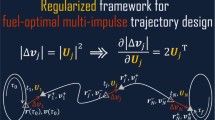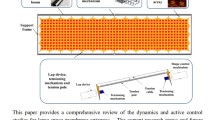Abstract
Modern space vehicles structure requisites are getting more and more stringent and complex as mission tasks become more sophisticated. This leads to the necessity of developing analysis methods that take into account structure flexibility and the need of reducing manoeuvre time as much as possible. In this work, a method based on the Hamilton Principle in its weak mixed form is developed, in which co-ordinates derivatives do not appear, but only their virtual variations. The proposed formulation is able to take into account system flexibility and saturation constraints on control torques and forces. A non-linear variational condition is obtained, which can be solved by means of a time-finite-element technique to give the minimum-time solutions of the control problem. The solutions for slewing manoeuvres are given, along with a new solution of the distributed optimal control problem.
Similar content being viewed by others
References
Modi, V.J., Ng, A.C. and Karray, F., ‘A general formulation for the nonlinear dynamics and control of orbiting flexible structures’, Comput. Mech. 13(3) (1993) 204–230.
Modi, V.J., Ng, A.C. and Karray, F., ‘Slewing dynamics and control of the space station-based mobile servicing system’, Acta Astronautica, 35(2–3) (1995) 119–129.
Kumar, A.U., Seywald, R.R., Deshpande, H. and Rahaman, S.M.,‘Artificial neural networks in-space station optimal attitude-control’, Acta Astronautica 35(2–3) (1995) 107–117.
Turner, J.D. and Junkins, J.L., ‘Optimal large-angle single-axis rotational maneuvers of flexible spacecraft’, J. Guidance Control 3(6) (1980) 578–585.
Turner, J.D. and Chun, H.M., ‘Optimal distributed control of a flexible spacecraft during a large-angle maneuver’, J. Guidance Control Dynamics 7(3) (1984) 257–264.
Singh, G., Kabamba, P.T. and McClamroch, N.H., ‘Planar, time-optimal, rest-to-rest slewing maneuvers of flexible spacecraft’, J. Guidance Control Dynamics 12(1) (1989) 71–81.
Shen, Q., Soudack, A.C. and Modi, V.J., ‘Analytical solution of attitude motion for spacecraft with a slewing appendage’, Nonlinear Dynamics 6(22)(1994) 193–214.
Bailey, C.D., ‘Application of Hamilton's law of varying action’, AIAA J. 13(9) (1975) 1154–1157.
Borri, M., Ghiringhelli, G.L., Lanz, M., Mantegazza, P. and Merlini, T., ‘Dynamic response of mechanical systems by a weak Hamiltonian formulation’, Computer Structures 20(1–3) (1985) 495–508.
Hodges, D.H. and Bless, R.R., ‘Weak Hamiltonian finite element method for optimal control problems’, J. Guidance Control Dynamics 14(1) (1991) 148–156.
Oz, H. and Adiguzel, E., ‘Hamilton's law of varying action. 1. Assumed-time-modes method’, J. Sound Vibration 179(4) (1995) 697–710.
Oz, H. and Adiguzel, E., ‘Hamilton's law of varying action. 2. Direct optimal-control of linear systems’, J. Sound Vibration 179(4) (1995) 711–724.
Kreindler, E., ‘Additional necessary conditions for optimal control with state-variable inequality constraints,’ J. Optimization Theory Applications 38(2) (1982) 241–250.
Borri, M. and Bottasso, C., ‘A general framework for interpreting time-finite-element formulations’, Comput. Mech. 13(4) (1993) 133–142.
Hulbert, G.M., ‘Time finite element methods for structural dynamics’, Int. J. Numerical Methods Eng. 33 (1992) 307–331.
Di Meglio, A., Il Principio di Hamilton per il Controllo Ottimo in Tempo Minimo di Veicoli Spaziali Flessibili, Master degree thesis in Aerospace Mechanics, Politecnico di Milano 1993.
Meirovitch, L. and Quinn, R.D., ‘Equations of motion for maneuvering flexible spacecraft’, J. Guidance Control Dynamics 10(5) (1987) 453–465.
Author information
Authors and Affiliations
Rights and permissions
About this article
Cite this article
Di Meglio, A., Ercoli Finzi, A. Minimum Time Control of Flexible Spacecraft by Hamilton's Principle. Meccanica 32, 555–565 (1997). https://doi.org/10.1023/A:1004204510722
Issue Date:
DOI: https://doi.org/10.1023/A:1004204510722




